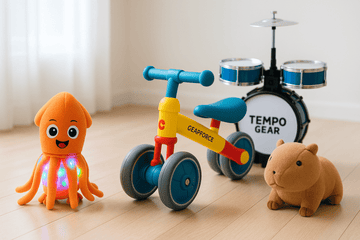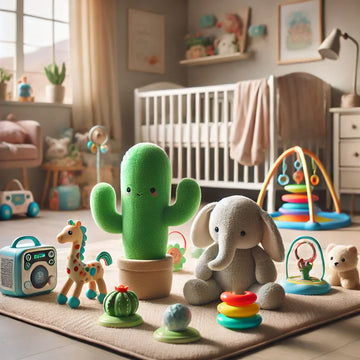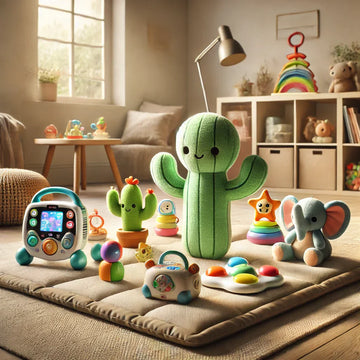Dancing cactus toys have captivated children and adults for years with their whimsical movements and quirky charm. Whether you're watching their playful swaying or considering their underlying mechanics, these toys are far more intriguing than they appear at first glance. But have you ever wondered about the science that makes them move? How do these toys balance and dance so effortlessly? In this article, we’ll delve into the fascinating mechanics of dancing cactus toys, explore their educational benefits, and uncover why they remain a popular source of entertainment.
What Are Dancing Cactus Toys?
At their core, dancing cactus toys are playful, interactive figurines designed to mimic a dancing motion. They often feature a cactus-shaped base, which gives them their iconic look, and a figurine or appendage that appears to sway or dance. These toys typically rely on vibrations or programmed mechanisms to create movement, which gives them an amusing lifelike quality.
Their popularity lies in their simplicity and universal appeal. Adults love their novelty and charm, while children are enchanted by their animated movements and the sensory stimulation they provide. But to fully appreciate these toys, it’s essential to understand the science that powers them.
The Mechanics of Dancing Cactus Toys
The magic behind dancing cactus toys can be broken into three key scientific principles: motion, balance, and vibration. Each of these elements plays a critical role in the toy's operation, working together seamlessly to create the iconic "dancing" effect. To learn more, explore the science behind dancing toys.
The Science of Motion: Newton’s Laws at Play
The movement of dancing cactus toys is governed by the fundamental laws of motion formulated by Sir Isaac Newton. These principles provide the foundation for understanding how the toys behave:
-
Newton’s First Law of Motion
An object at rest will remain at rest, and an object in motion will remain in motion unless acted upon by an external force.- In the case of dancing cactus toys, the base remains stationary until vibrations or external forces (like music or a person’s touch) are introduced. These forces set the figurine in motion.
-
Newton’s Second Law of Motion
The acceleration of an object is directly proportional to the force applied to it and inversely proportional to its mass.- When the toy’s base vibrates, the figurine’s acceleration depends on the intensity of the vibration and its mass. Lightweight parts tend to move more dramatically, creating the characteristic swaying or dancing motion.
-
Newton’s Third Law of Motion
For every action, there is an equal and opposite reaction.- As the base vibrates, it exerts force on the figurine, which responds with a counter-movement. This creates the back-and-forth motion that resembles dancing.
Balance: A Crucial Factor
For a dancing cactus toy to perform effectively, balance is critical. Without proper balance, the toy would topple over instead of dancing gracefully. Balance is maintained through careful consideration of weight distribution, center of gravity, and friction:
-
Weight Distribution
The toy's design ensures that its weight is evenly distributed. This prevents the toy from tilting excessively or falling over during movement. The base is often slightly weighted to keep it stable. -
Center of Gravity
The center of gravity is the point where the weight of the toy is evenly balanced. In a well-designed dancing cactus toy, this point is typically located near the base, ensuring stability even during vigorous motion. -
Friction
Friction between the base and the surface it sits on prevents sliding. Without enough friction, the toy would skid across the table rather than remaining stationary and "dancing."
Vibration: The Driving Force Behind the Dance
The signature motion of a dancing cactus toy is driven by vibrations. These vibrations can come from various sources, such as built-in motors, external music, or manual stimulation. Here’s how it works:
-
Built-In Motors
Many modern dancing cactus toys are powered by small electric motors. These motors produce vibrations that cause the toy to sway rhythmically. -
External Stimuli
Some toys are designed to respond to external stimuli, such as music or touch. Sensors within the toy detect sound waves or physical interaction, triggering the motor to start the dancing motion. -
Oscillatory Movement
The vibrations shift the toy’s center of gravity repeatedly, causing it to rock back and forth. This oscillatory movement is what creates the illusion of dancing.
Educational and Developmental Benefits of Dancing Cactus Toys
While dancing cactus toys are undeniably entertaining, they also offer surprising educational and developmental benefits. These benefits make them more than just a novelty item—they’re also a valuable learning tool for children and even adults. These toys help develop fine motor skills in children through interactive play.
Teaching Physics Through Play
Dancing cactus toys provide a hands-on way to learn about physics concepts like motion, balance, and vibration. For instance:
-
Motion
Children can observe how forces cause movement and experiment with how different surfaces or intensities of vibration affect the toy's dance. -
Balance
By tilting or adjusting the toy, kids can see how changes in the center of gravity impact stability. -
Cause and Effect
Interacting with the toy teaches the concept of cause and effect, as children learn that their actions (e.g., touching or tapping the toy) produce specific reactions (dancing).
Sensory Stimulation and Cognitive Development
The movement, sound, and often colorful appearance of dancing cactus toys provide excellent sensory stimulation. This can be especially beneficial for young children or individuals with sensory processing needs:
-
Visual and Auditory Engagement
The bright colors and rhythmic movements capture attention, while accompanying music or sound effects enhance auditory processing. -
Fine Motor Skills
Interacting with the toy—such as turning it on, tapping it, or repositioning it—helps develop fine motor coordination.
Promoting Creativity and Imaginative Play
Dancing cactus toys encourage open-ended play. Children might create stories or scenarios involving the toy, fostering creativity and imagination. For example:
- Acting as DJs or musicians, children can "make" the toy dance to their favorite tunes.
- Pretending the cactus is a character in a story, leading to role-playing opportunities.
The Popularity of Dancing Cactus Toys
The appeal of dancing cactus toys transcends age and geography. But what makes these toys so universally beloved?
Nostalgia Meets Novelty
For adults, dancing cactus toys evoke nostalgia while offering a novel twist. Their simple mechanisms harken back to old-fashioned wind-up toys, yet their interactive features make them modern and engaging.
Stress Relief and Entertainment
The rhythmic movement of dancing cactus toys can be surprisingly soothing. Many adults use them as a perfect stress reliever, enjoying their rhythmic, soothing movements.
Viral Sensation
In recent years, dancing cactus toys have gained popularity on social media platforms like TikTok. Their quirky movements and playful appearance make them perfect for short, shareable videos that resonate with audiences worldwide.
For these reasons, it’s no surprise why every home needs one of these delightful toys.
Conclusion: The Enduring Charm of Dancing Cactus Toys
Dancing cactus toys are more than just whimsical figurines; they are marvels of simple science and engineering. By combining the principles of motion, balance, and vibration, these toys create a unique and entertaining experience for users of all ages. Beyond their entertainment value, they offer a wealth of educational benefits, from teaching physics to stimulating creativity.
As technology continues to advance, it’s exciting to imagine how these toys might evolve. Whether they incorporate more complex movements, interactive features, or AI-driven personalization, one thing is certain: the dancing cactus toy will continue to charm and captivate for generations to come.
So next time you watch one of these delightful toys in action, take a moment to appreciate the fascinating science that makes them move—and perhaps even share the wonder with someone else. Whether you're exploring the best dancing cactus toys available or marveling at their science, one thing is clear: they will continue to captivate.





